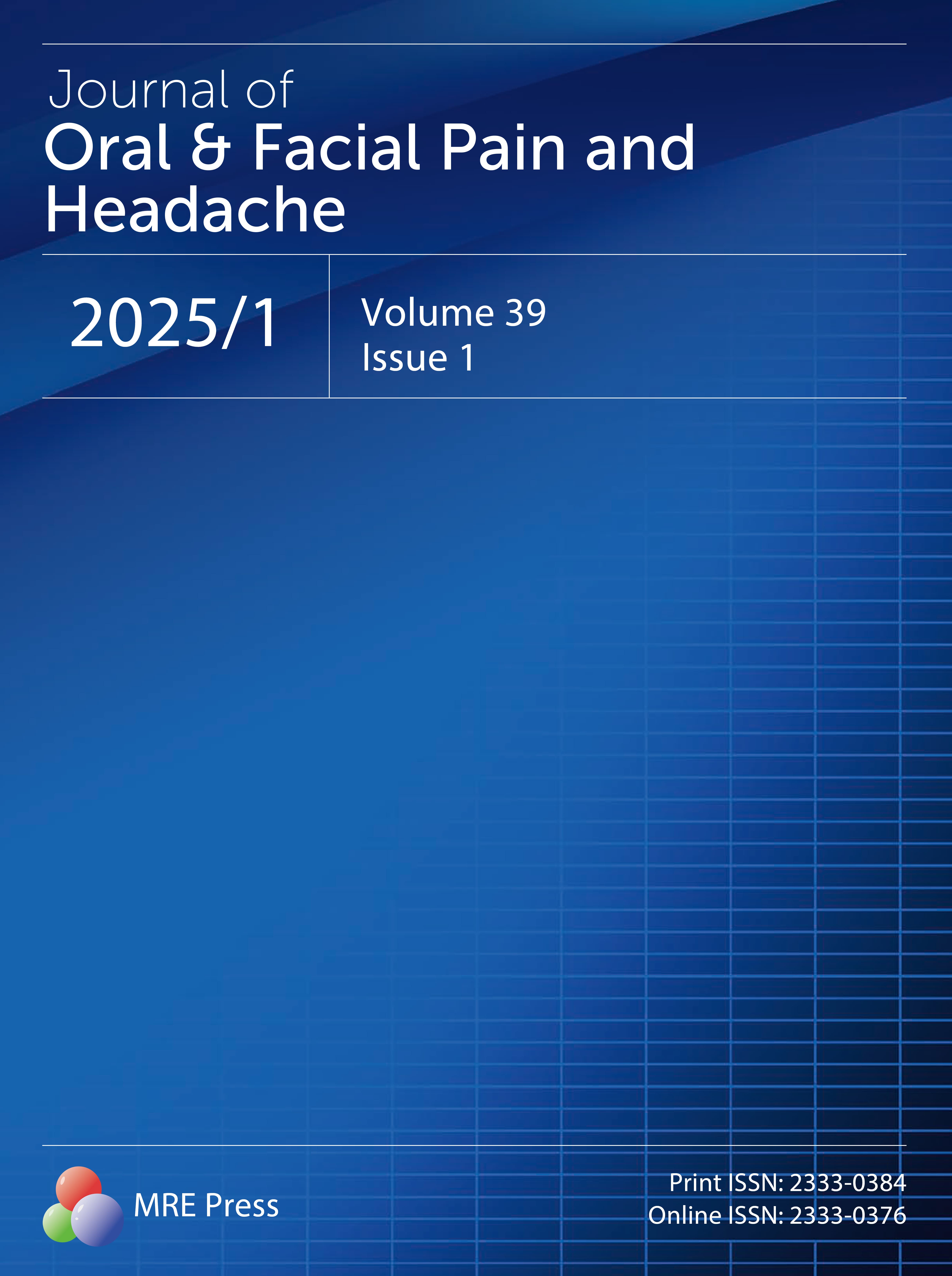Title
Author
DOI
Article Type
Special Issue
Volume
Issue
Article Menu
Export Article
More by Authors Links
Article Data
- Views 765
- Dowloads 52
Journal of Oral & Facial Pain and Headache (OFPH) is published by MRE Press from Volume 38 lssue 1 (2024). Previous articles were published by another publisher on a subscription basis, and they are hosted by MRE Press on www.jofph.com as a courtesy and upon agreement with Journal of Oral & Facial Pain and Headache.
Editorials
Open AccessTHE ETIOLOGY OF TEMPOROMANDIBULAR DISORDERS: IMPLICATIONS FOR TREATMENT
THE ETIOLOGY OF TEMPOROMANDIBULAR DISORDERS: IMPLICATIONS FOR TREATMENT
1Department of Prosthetic Dentistry/Dental Materials Science, Faculty of Odontology, Göteborg University, SE 405 30 Göteborg, Sweden
*Corresponding Author(s): Gunnar E. Carlsson E-mail: g_carlsson@odontologi.gu.se
Abstract
Cite and Share
Gunnar E. Carlsson. THE ETIOLOGY OF TEMPOROMANDIBULAR DISORDERS: IMPLICATIONS FOR TREATMENT. Journal of Oral & Facial Pain and Headache. 2001. 15(2);106-108.
References
1. Greene CS. Focus article: The etiology of temporomandibular disorders: Implications for treatment. J Orofac Pain 2001;15:93–105.
2. De Boever JA, Carlsson GE. Etiology and differential diagnosis. In: Zarb GA, Carlsson GE, Sessle BJ, Mohl ND (eds). Temporomandibular Joint and Masticatory Muscle Disorders. Copenhagen: Munksgaard, 1994:171–187.
3. American Academy of Orofacial Pain, Okeson JP (ed). Orofacial Pain: Guidelines for Assessment, Diagnosis, and Management. Chicago: Quintessence, 1996.
4. Woda A, Pionchon P. Focus paper: A unified concept of idiopathic orofacial pain: Clinical features. J Orofac Pain 1999;13:172–184.
5. Okeson JP. Critical commentary 2: A unified concept of idiopathic orofacial pain: Clinical features. J Orofac Pain 1999;13:189–191.
6. Glaros AG, Glass EG, McLaughlin L. Knowledge and beliefs of dentists regarding temporomandibular disorders and chronic pain. J Orofac Pain 1994;8:216–223.
7. Arbree NS, Campbell SD, Renner RP, Goldstein GR. A survey of temporomandibular disorders conducted by the greater New York Academy of Prosthodontists. J Prosthet Dent 1995;74:512–516.
8. MacNamara JA, Seligman DA, Okeson JP. Occlusion, orthodontic treatment, and temporomandibular disorders: A review. JOrofac Pain 1995;9:73–90.
9. De Boever JA, Carlsson GE, Klineberg IJ. Need for occlusal therapy and prosthodontic treatment in the management of temporomandibular disorders. Part I. Occlusal interferences and occlusal adjustment. J Oral Rehabil 2000;27:367–379.
10. De Boever JA, Carlsson GE, Klineberg IJ. Need for occlusal therapy and prosthodontic treatment in the management of temporomandibular disorders. Part II. Tooth loss and prosthodontic treatment. J Oral Rehabil 2000;27:647–659.
11. Dawson P. Position paper regarding diagnosis, management and treatment of temporomandibular disorders. The Equlibration Society. J Prosthet Dent 1999;81:174–178.
12. Kirveskari P, Jämsä T, Alanen P. Occlusal adjustment and the incidence of demand for temporomandibular disorder treatment. J Prosthet Dent 1998;79:433–438.
13. Vallon D. Studies of Occlusal Adjustment Therapy in Patients with Craniomandibular Disorders [thesis]. Swed Dent J 1997;Suppl 124:1–65.
14. Raphael K, Marbach JJ. Evidence-based care of musculoskeletal facial pain: Implications for the clinical science of dentistry. J Am Dent Assoc 1997;128:73–77.
15. Moses AJ. Readers’ Round Table—AES/Alliance [editorial]. J Prosthet Dent 1999;82:117–120.
16. Axelsson P. Diagnosis and Risk Prediction of Dental Caries. Chicago: Quintessence, 2000.
17. Zickert I, Jonson Å, Klock B, Krasse B. Disease activity and need for dental care in a capitation plan based on risk assessment. Br Dent J 2000;189:480–486.
18. Baum BJ. Crowning achievements in dentistry. The Lancet 1999 Dec;354(Suppl):SIV12.
19. Stohler CS, Zarb GA. On the management of temporomandibular disorders: A plea for a low-tech, high-prudence therapeutic approach. J Orofac Pain 1999;13: 255–261.
20. Carlsson GE, Magnusson T. Management of Temporomandibular Disorders in the General Dental Practice. Chicago: Quintessence, 1999.

Abstracted / indexed in
Science Citation Index (SCI)
Science Citation Index Expanded (SCIE)
BIOSIS Previews
Scopus
Cumulative Index to Nursing and Allied Health Literature (CINAHL)
Submission Turnaround Time
Editorial review: 1 - 7 days
Peer review: 1 - 3 months
Publish Ahead of Print: within 2 months after being accepted
Notes: Your information is kept confidential throughout the review process.
Top
